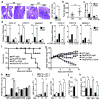OTUD7B controls non-canonical NF-κB activation through deubiquitination of TRAF3
- PMID: 23334419
- PMCID: PMC3578967
- DOI: 10.1038/nature11831
OTUD7B controls non-canonical NF-κB activation through deubiquitination of TRAF3
Abstract
The non-canonical NF-κB pathway forms a major arm of NF-κB signalling that mediates important biological functions, including lymphoid organogenesis, B-lymphocyte function, and cell growth and survival. Activation of the non-canonical NF-κB pathway involves degradation of an inhibitory protein, TNF receptor-associated factor 3 (TRAF3), but how this signalling event is controlled is still unknown. Here we have identified the deubiquitinase OTUD7B as a pivotal regulator of the non-canonical NF-κB pathway. OTUD7B deficiency in mice has no appreciable effect on canonical NF-κB activation but causes hyperactivation of non-canonical NF-κB. In response to non-canonical NF-κB stimuli, OTUD7B binds and deubiquitinates TRAF3, thereby inhibiting TRAF3 proteolysis and preventing aberrant non-canonical NF-κB activation. Consequently, the OTUD7B deficiency results in B-cell hyper-responsiveness to antigens, lymphoid follicular hyperplasia in the intestinal mucosa, and elevated host-defence ability against an intestinal bacterial pathogen, Citrobacter rodentium. These findings establish OTUD7B as a crucial regulator of signal-induced non-canonical NF-κB activation and indicate a mechanism of immune regulation that involves OTUD7B-mediated deubiquitination and stabilization of TRAF3.
Conflict of interest statement
The authors declare no competing financial interests.
Figures




Similar articles
-
OTUD7B suppresses Smac mimetic-induced lung cancer cell invasion and migration via deubiquitinating TRAF3.J Exp Clin Cancer Res. 2020 Nov 16;39(1):244. doi: 10.1186/s13046-020-01751-3. J Exp Clin Cancer Res. 2020. PMID: 33198776 Free PMC article.
-
Roles of TRAF2 and TRAF3 in Epstein-Barr virus latent membrane protein 1-induced alternative NF-kappaB activation.Virus Genes. 2010 Oct;41(2):174-80. doi: 10.1007/s11262-010-0505-4. Epub 2010 Jun 29. Virus Genes. 2010. PMID: 20585848
-
Noncanonical NF-κB activation by the oncoprotein Tio occurs through a nonconserved TRAF3-binding motif.Sci Signal. 2013 Apr 23;6(272):ra27. doi: 10.1126/scisignal.2003309. Sci Signal. 2013. PMID: 23612708
-
A20-mediated negative regulation of canonical NF-κB signaling pathway.Immunol Res. 2013 Dec;57(1-3):166-71. doi: 10.1007/s12026-013-8463-2. Immunol Res. 2013. PMID: 24242761 Review.
-
TRAF3 as a Multifaceted Regulator of B Lymphocyte Survival and Activation.Front Immunol. 2018 Sep 24;9:2161. doi: 10.3389/fimmu.2018.02161. eCollection 2018. Front Immunol. 2018. PMID: 30319624 Free PMC article. Review.
Cited by
-
Signaling mechanisms regulating B-lymphocyte activation and tolerance.J Mol Med (Berl). 2015 Feb;93(2):143-58. doi: 10.1007/s00109-015-1252-8. Epub 2015 Jan 29. J Mol Med (Berl). 2015. PMID: 25627575 Review.
-
Divergence in Ubiquitin Interaction and Catalysis among the Ubiquitin-Specific Protease Family Deubiquitinating Enzymes.Biochemistry. 2016 Aug 23;55(33):4708-19. doi: 10.1021/acs.biochem.6b00033. Epub 2016 Aug 8. Biochemistry. 2016. PMID: 27501351 Free PMC article.
-
The diversity of linkage-specific polyubiquitin chains and their role in synaptic plasticity and memory formation.Neurobiol Learn Mem. 2020 Oct;174:107286. doi: 10.1016/j.nlm.2020.107286. Epub 2020 Aug 1. Neurobiol Learn Mem. 2020. PMID: 32745599 Free PMC article. Review.
-
Salvia miltiorrhiza-derived miRNAs suppress vascular remodeling through regulating OTUD7B/KLF4/NMHC IIA axis.Theranostics. 2020 Jun 19;10(17):7787-7811. doi: 10.7150/thno.46911. eCollection 2020. Theranostics. 2020. PMID: 32685020 Free PMC article.
-
Activated CLL cells regulate IL-17F-producing Th17 cells in miR155-dependent and outcome-specific manners.JCI Insight. 2022 Jun 22;7(12):e158243. doi: 10.1172/jci.insight.158243. JCI Insight. 2022. PMID: 35511436 Free PMC article.
References
-
- Dejardin E. The alternative NF-kappaB pathway from biochemistry to biology: pitfalls and promises for future drug development. Biochem Pharmacol. 2006;72:1161–1179. - PubMed
-
- Razani B, Reichardt AD, Cheng G. Non-canonical NF-kappaB signaling activation and regulation: principles and perspectives. Immunol Rev. 2011;244:44–54. - PubMed
-
- Senftleben U, et al. Activation of IKKa of a second, evolutionary conserved, NF-kB signaling pathway. Science. 2001;293:1495–1499. - PubMed
-
- Xiao G, Harhaj EW, Sun SC. NF-kappaB-inducing kinase regulates the processing of NF-kappaB2 p100. Mol Cell. 2001;7:401–409. - PubMed
Publication types
MeSH terms
Substances
Grants and funding
LinkOut - more resources
Full Text Sources
Other Literature Sources
Molecular Biology Databases
Research Materials

